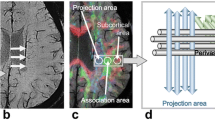Abstract
Introduction
The purpose of this study was to assess the usefulness of signs (“Sukeroku sign” and “dent internal-capsule sign”) for the recognition of subthalamic nucleus (STN).
Materials and methods
Five Parkinson’s disease cases in which there was a successful placement of deep brain stimulation (DBS) electrodes at the STN were retrospectively reviewed. Five radiologists who were not engaged in localization of STNs in clinical practice were asked to locate the STNs before and after instructions on the signs. We evaluated the deviation between the reader-located points and the location of the DBS electrode for which there had been a successful installation.
Results
After instruction, there was a significant reduction in the deviation between the reader-located points and the DBS electrode. The time required for localization was also reduced after the instructions.
Conclusion
Sukeroku sign and dent internal-capsule sign are feasible indicators of STN and seem to be useful in helping to identify the STN.


Similar content being viewed by others
References
Bejjani BP, Dormont D, Pidoux B et al (2000) Bilateral subthalamic stimulation for Parkinson’s disease by using three-dimensional stereotactic magnetic resonance imaging and electrophysiological guidance. J Neurosurg 92:615–625
Ostergaard K, Sunde N, Dupont E (2002) Effects of bilateral stimulation of the subthalamic nucleus in patients with severe Parkinson’s disease and motor fluctuations. Mov Disord 17:693–700 doi:10.1002/mds.10188
Furumoto H (2004) Excessive daytime somnolence in Japanese patients with Parkinson’s disease. Eur J Neurol 11:535–540 doi:10.1111/j.1468-1331.2004.00827.x
Haines DE (2003) Neuroanatomy: an atlas of structures, sections, and systems. Lippincott Williams & Wilkins, Philadelphia
Aziz TZ, Nandi D, Parkin S et al (2001) Targeting the subthalamic nucleus. Stereotact Funct Neurosurg 77:87–90 doi:10.1159/000064602
den Dunnen WF, Staal MJ (2005) Anatomical alterations of the subthalamic nucleus in relation to age: a postmortem study. Mov Disord 20:893–898 doi:10.1002/mds.20417
Starr PA, Vitek JL, DeLong M, Bakay RA (1999) Magnetic resonance imaging-based stereotactic localization of the globus pallidus and subthalamic nucleus. Neurosurgery 44:303–313 doi:10.1097/00006123-199902000-00031, discussion 313–304
Starr PA, Christine CW, Theodosopoulos PV et al (2002) Implantation of deep brain stimulators into the subthalamic nucleus: technical approach and magnetic resonance imaging-verified lead locations. J Neurosurg 97:370–387
Zonenshayn M, Rezai AR, Mogilner AY, Beric A, Sterio D, Kelly PJ (2000) Comparison of anatomic and neurophysiological methods for subthalamic nucleus targeting. Neurosurgery 47:282–292 doi:10.1097/00006123-200008000-00005, discussion 292–284
Hariz MI, Krack P, Melvill R et al (2003) A quick and universal method for stereotactic visualization of the subthalamic nucleus before and after implantation of deep brain stimulation electrodes. Stereotact Funct Neurosurg 80:96–101 doi:10.1159/000075167
Richter EO, Hoque T, Halliday W, Lozano AM, Saint-Cyr JA (2004) Determining the position and size of the subthalamic nucleus based on magnetic resonance imaging results in patients with advanced Parkinson disease. J Neurosurg 100:541–546
Schaltenbrand G, Wahren W (1998) Atlas for stereotaxy of the human brain. Thieme, Stuttgart
Acknowledgment
We deeply appreciate the Research and Training Department, Japan Art Council for the permission granted for us to use the “Ukiyo-e” print of “Sukeroku” in this article and for providing us a copy of the fine art.
Conflict of interest statement
We declare that we have no conflict of interest.
Author information
Authors and Affiliations
Corresponding author
Rights and permissions
About this article
Cite this article
Taoka, T., Hirabayashi, H., Nakagawa, H. et al. “Sukeroku sign” and “dent internal-capsule sign”—identification guide for targeting the subthalamic nucleus for placement of deep brain stimulation electrodes. Neuroradiology 51, 11–16 (2009). https://doi.org/10.1007/s00234-008-0451-1
Received:
Accepted:
Published:
Issue Date:
DOI: https://doi.org/10.1007/s00234-008-0451-1




